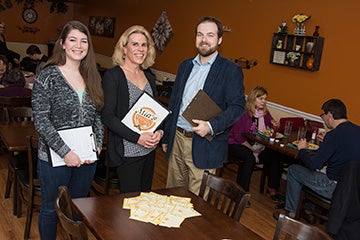Lunch: Would you pay if you didn’t have to?
A business professor explores a very different approach to dropping the check
Naming your price isn’t usually a menu option, but an experiment by Assistant Professor of Marketing Stephen Atlas shows it might leave both diner and restaurant owner feeling satisfied.
Atlas, whose research specialty is consumer-purchasing behavior, had heard of the phenomenon of pay-what-you-want pricing in some urban restaurants. Armed with a $15,000 URI grant to help offset potential business losses, he roped in Mia Rao, the owner of Mia’s Kitchen in Kingston, to explore a twist on the model: rebate-driven pricing.

In other experiments, Atlas explains, customers have been asked to simply set a price for their soup or sandwich. “They often elect to pay less than the menu price,” he says. “Although this may generate valuable news coverage, goodwill and customer feedback, it’s typically not a sustainable business practice.”
He wanted to know what would happen if customers first paid full price, then decided how much they got back. So he worked with Rao to set it up.
Diners came into the restaurant without suspecting they were being studied. Then, at the end of the meal, servers included a card with the check. Each card explained a randomly assigned tweak on the usual payment system. Some diners were offered the option of choosing to pay any portion of the menu price; others could request a full or partial rebate instantly; and others were asked to mail in a rebate form for any amount, including a full refund.
The results: After accounting for discounts, diners paid the most if they needed to mail in a rebate. They paid less if they picked their own price directly, and they paid the least when they picked their own instant rebate.
But the big surprise, Atlas says, was that in all three scenarios, diners still paid up—handsomely.
“After accounting for tips, diners averaged payments that were more than the asking price,” Atlas says, “despite being told when they received their bill that they could have received a free meal.”
In fact, of nearly 150 diners, nobody paid $0. Only four diners, or 3 percent, paid less than half of the asking price.
 Home
Home Browse
Browse Close
Close Events
Events Maps
Maps Email
Email Brightspace
Brightspace eCampus
eCampus


